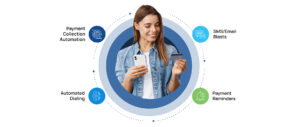Discover the Intersection of
Collections and AI
Built to perform across the customer journey.

The collections landscape has evolved significantly, particularly with the increased adoption of technology. Yet, many collection agencies are only scraping the surface of what’s possible, relying primarily on automation without embedding intelligence into their campaigns. To understand how debt collection campaigns can be improved beyond traditional methods, let’s explore what typical collections campaigns look like today, their limitations, and a new vision for intelligent collections.
Debt Collection campaigns are systematic collection efforts by financial institutions, lenders, and collection agencies to recover overdue customer payments. The primary goal is to encourage customers to settle outstanding debts while maintaining a positive customer relationship. These campaigns can vary widely, from automated reminders sent through SMS to detailed follow-ups requiring live conversations between agents and customers.
Traditional debt collection campaigns typically follow a straightforward structure:
This traditional approach relies primarily on task automation for speed and efficiency but lacks personalization, intelligence, and flexibility.

Automation in debt collection campaigns uses technology and AI-driven tools to streamline various aspects of the collection process. These tools can make communication more consistent, reduce the need for manual labor, and improve efficiency, though their effectiveness can depend on how they are implemented. Here’s an expanded overview of how different elements of automation in debt collection campaigns work:
Voicebots can further enhance efficiency by handling tasks like payment reminders or account verification but may lack the personal touch for complex issues.
Automated SMS and email systems allow debt collection agencies to send a large volume of messages with minimal manual effort. These communications can serve a variety of purposes, such as:
Personalization based on customer data can improve engagement, though overly generic messages may feel impersonal.
Automated payment reminders are a key use of AI in debt collection. These systems can be set to send reminders at predefined times, ensuring that customers receive consistent notifications about upcoming or overdue payments. These reminders can be scheduled at various intervals and delivered via SMS, email, or phone, offering flexibility to match customer preferences. While effective, overusing reminders may annoy customers, so balancing frequency and content is crucial to maintaining positive relationships.
Payment automation systems enable customers to make payments directly via a text-based link sent to their phone or email. This system embeds a secure payment link in a message that directs the customer to a payment portal.
Despite the push for automation, many of today’s debt collection campaigns still fall short due to the following challenges:
In this environment, it’s easy for both customers and agents to feel frustrated and disconnected. Campaigns feel impersonal to customers and inefficient for agents, leading to suboptimal results for both parties.
Intelligent debt collections refer to collection efforts driven by advanced technology, specifically through Collection Orchestration Platforms (COPs). These platforms utilize a Large Collection Model (LCM), a strategy engine designed to predict the likelihood of successful collections by analyzing consumer demographics and debt details. The LCM recommends the most effective communication channel and approach to maximize outcomes while minimizing time and effort.
In simpler terms, intelligent debt collections leverage consumer data—such as payment behavior, preferred communication channels, and other relevant details—to create targeted, personalized strategies for managing each debt account. This tailored approach increases the probability of successful collections.
At the core of this process is the Collection Orchestration Platform, powered by the LCM, which functions as a specialized Large Language Model (LLM) fine-tuned exclusively for debt collection tasks.
Automation in debt collections has undoubtedly advanced beyond traditional methods, but it alone is not sufficient in today’s landscape. In an era where personalization and targeted customer experiences are of utmost importance, the debt collection industry must evolve alongside technological advancements. While some collectors have embraced smarter, data-driven strategies to enhance efficiency and recovery rates, it is imperative for others to adopt these innovations to remain competitive and effective.
Are you ready to take the next step toward call automation with Conversational AI? Schedule a free demo with one of our experts to learn more!
Built to perform across the customer journey.

 Part 2 – Beyond Automation: Intelligent Collections and Efficient Debt...
Part 2 – Beyond Automation: Intelligent Collections and Efficient Debt...